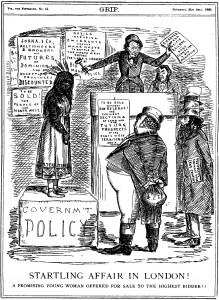Written by guest blogger, Carmen Nielson.
First Nations, Métis and Inuit women have been working for a very long time to decolonize their representation in the Canadian mainstream. The First Nations collective ReMatriate – founded in response to Canadian designer Dsquared2’s 2015 launch of a new line dubbed #Dsquaw – is just one example of Indigenous women mobilizing to reclaim their “visual identity” (to quote Claire Anderson). The power to represent oneself, to control how others see us, is a privilege that has been systematically denied to oppressed and marginalized peoples. Indigenous women’s struggle to resist and replace negative and reductionist depictions is essential to dismantling colonial power relations in Canada. These images matter.
When I came upon caricatures of Indigenous women in Canada’s late nineteenth-century satirical magazine Grip, I knew that these images also mattered. In “Caricaturing Colonial Space: Indigenized, Feminized Bodies and Anglo-Canadian Identity, 1873-94” I argue that cartoon depictions of Indigenous women were not merely reiterations of racist and sexist stereotypes. These images also compelled political and personal investments in the colonial project amongst Anglo-Canadian viewers. In other words, the collaboration and consent required from settler-citizens to legitimize political and administrative processes that subjected Indigenous land and peoples to state governance was constituted, at least in part, in images.
Despite Indigenous women’s on-going resistance and resilience, Canada’s colonial project has had devastating effects, including the normalization of gender violence. The Liberal government’s December 2015 decision to establish a national inquiry on murdered and missing women comes after decades of Indigenous activism calling for meaningful action. As Jaskiran Dhillon and Siku Allooloo have recently argued in the Guardian, the inquiry must confront “Canada’s ugly and violent colonial history” and the “targeted gender violence” that enabled the nation’s formation. If it fails to do so, the inquiry will amount to an “affront, [and] will add further injury to indigenous peoples.”
Degrading and racist images of Indigenous women are important parts of that “ugly and violent colonial history.” I hope my article will provide opportunities for us, as teachers, to help our students understand Canada’s colonial past and its links to the present, and to think through relationships between power and representations, culture and politics, images and lived experiences. By paying closer attention to images, perhaps we will be able to envision a better future.
Carmen Nielson’s article, “Caricaturing Colonial Space: Indigenized, Feminized Bodies and Anglo-Canadian Identity, 1873–94” appears in the latest edition of the Canadian Historical Review. Read it today at CHR Online – http://bit.ly/CHR964_Nielsonor on Project MUSE – http://bit.ly/CHR964PMNielson

Comments on this entry are closed.